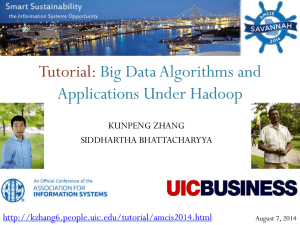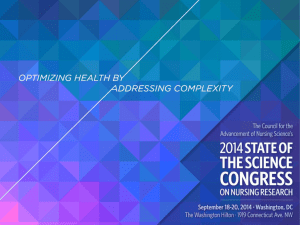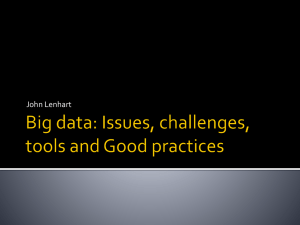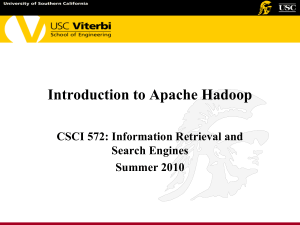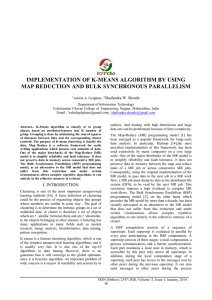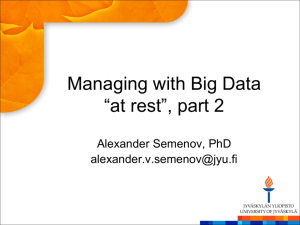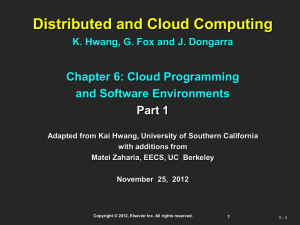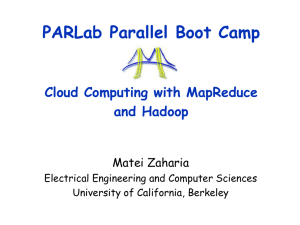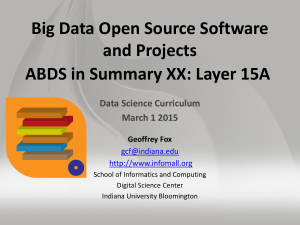PPT - Big Data Open Source Software and Projects
advertisement
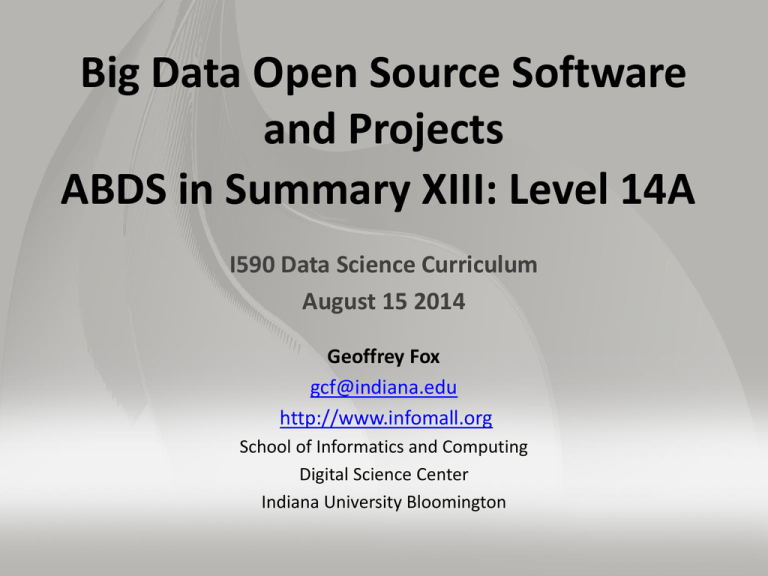
Big Data Open Source Software and Projects ABDS in Summary XIII: Level 14A I590 Data Science Curriculum August 15 2014 Geoffrey Fox gcf@indiana.edu http://www.infomall.org School of Informatics and Computing Digital Science Center Indiana University Bloomington 1) 2) 3) 4) 5) 6) 7) 8) 9) 10) 11) 12) 13) 14) 15) 16) 17) HPC-ABDS Layers Message Protocols Distributed Coordination: Security & Privacy: Monitoring: IaaS Management from HPC to hypervisors: DevOps: Interoperability: Here are 17 functionalities. Technologies are File systems: presented in this order Cluster Resource Management: 4 Cross cutting at top Data Transport: 13 in order of layered diagram starting at SQL / NoSQL / File management: bottom In-memory databases&caches / Object-relational mapping / Extraction Tools Inter process communication Collectives, point-to-point, publish-subscribe Basic Programming model and runtime, SPMD, Streaming, MapReduce, MPI: High level Programming: Application and Analytics: Workflow-Orchestration: Hadoop (MapReduce) • Key algorithm supported by Hadoop for processing of large data sets in a parallel, distributed fashion • A two step process: data filtering and sorting (map) and data summarization (reduce) • Hadoop has become ubiquitous, used by more than half of Fortune 50 companies. Installations are enormous, Facebook stated in 2012 that they added 0.5 PB daily to their cluster. • MapReduce concept originated at Google (2004), Hadoop implementation grew out of Nutch search engine, largely developed at Yahoo • http://www.revelytix.com/?q=content/hadoop-ecosystem describes many components of Hadoop ecosystem Apache Spark • Apache Spark is a general purpose computing framework aimed at large data analytics applications. • Spark APIs allow for programming in Java, Python or Scala, and are meant to be simple to understand and use to support rapid development. • Spark includes a set of tools to integrate tasks such as streaming, querying, graphing and machine learning. • Spark is a young project, only becoming an Apache top level project in February of 2014. Execution speed is a primary goal, with some types of applications running up to 100 times faster with Spark than with Hadoop. Twister • MapReduce programming model has simplified the implementations of many data parallel applications. The simplicity of the programming model and the quality of services provided by many implementations of MapReduce attract a lot of enthusiasm among parallel computing communities. • From the years of experience in applying MapReduce programming model to various scientific applications we identified a set of extensions to the programming model and improvements to its architecture that will expand the applicability of MapReduce to more classes of applications. Twister is a lightweight MapReduce runtime developed at Indiana University by incorporating these enhancements. • • • • • • • • • • • BSD style license http://www.iterativemapreduce.org/ Distinction between static and variable data Configurable long running (cacheable) map/reduce tasks Pub/sub messaging based communication/data transfers using ActiveMQ Efficient support for Iterative MapReduce computations (much faster than Hadoop or Dryad/DryadLINQ) Combine phase to collect all reduce outputs Data access via local disks Lightweight (~5600 lines of Java code) Support for typical MapReduce computations Tools to manage data Automatically recover from faults when FaultTolerance is enabled Stratosphere / Apache Flink • Originally developed in Germany but now Apache Flink http://flink.incubator.apache.org/. The Apache Flink stack consists of – Programming APIs for different languages (Java, Scala) and paradigms (record-oriented, graph-oriented). – A program optimizer that decides how to execute the program for good performance. It decides among other things about data movement and caching strategies. – A distributed runtime that executes programs in parallel distributed over many machines. Flink runs independently from Hadoop, but integrates seamlessly with YARN (Hadoop's next-generation scheduler). Various file systems (including the Hadoop Distributed File System) can act as data sources. Microsoft Reef • http://www.reef-project.org/ The Retainable Evaluator Execution Framework • This is a set of tools that building on Apache Yarn or Mesos (or Google Omega, and Facebook Corona) allow one to implement systems with capability of Hadoop and Spark • On these resource managers, REEF provides a centralized control plane abstraction that can be used to build a decentralized data plane for supporting big data systems, like those mentioned below. – Special consideration is given to graph computation and machine learning applications, which require data retention on allocated resources, as they execute multiple passes over the data. i.e. Reef supports iteration • More broadly, applications that run on YARN will have the need for a variety of data-processing tasks e.g., data shuffle, group communication, aggregation, checkpointing, and many more. Rather than re-implement these for each application, REEF aims to provide them in a library form, so that they can be reused by higher-level applications and tuned for a specific domain problem. Apache Hama • https://hama.apache.org/ • Apache Hama is a distributed computing framework based on Bulk Synchronous Parallel computing (BSP) techniques for massive scientific computations e.g., matrix, graph and network algorithms. • BSP is used in most MPI programs and involves coordinated communication separating computation (map) phases • Hama was inspired by Google's Pregel large-scale graph computing framework and is very similar in utility to the better known iterative MapReduce systems but directly supports Graph applications These types of plots are well known for Iterative MapReduce Hama much faster than Mahout on parallel K-means Apache Giraph • http://giraph.apache.org/ • Apache Giraph is an iterative graph processing system built for high scalability, to perform graph processing on big data. • Scalability and speed is impressive, for example Facebook used Giraph to analyze a trillion edges in 4 minutes. • Giraph originated as the open-source counterpart to Pregel, the graph processing architecture developed at Google and described in a 2010 paper. Both systems are inspired by the Bulk Synchronous Parallel model of distributed computation introduced by Leslie Valiant. • Giraph adds several features beyond the basic Pregel model, including master computation, sharded aggregators, edge-oriented input, out-of-core computation, and more. Pegasus • Apache License http://www.cs.cmu.edu/~Pegasus/ • http://www.cs.cmu.edu/~ukang/papers/PegasusICDM2009.pdf • PEGASUS is a Peta-scale graph mining system, fully written in Java. It runs in parallel, distributed manner on top of Hadoop. • PEGASUS provide large scale algorithms for important graph mining tasks such as: Degree, PageRank, Random Walk with Restart (RWR), Radius, and Connected Components • Graph Mining is an area of data mining to find patterns, rules, and anomalies of graphs. Graphs or networks are everywhere, ranging from the Internet Web graph, social networks (FaceBook, Twitter), biological networks, and many more. • Finding patterns, rules, and anomalies have numerous applications including, but not limited to, the followings: – – – – Ranking web pages by search engine 'viral' or 'word-of-mouth' marketing Patterns of disease with potential impact for drug discovery Computer network security: email/IP traffic and anomaly detection

